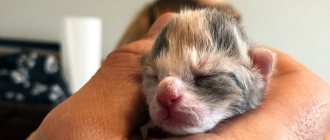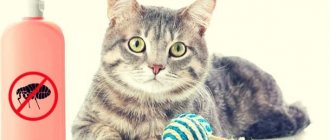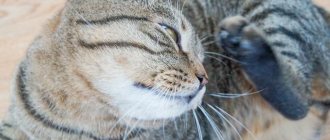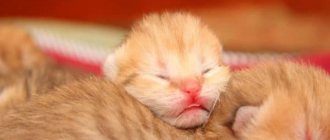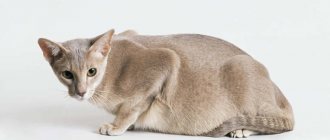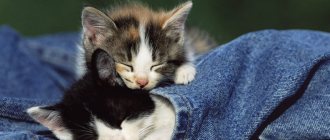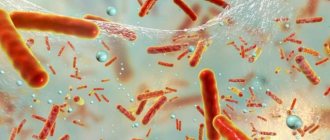Kittens, compared to adult cats, are more often attacked by various parasites.
Moreover, fleas are considered the most common among them. They cannot be removed from kittens using the usual means for adults. Their sensitive immune system will suffer greatly from such harsh exposure.
You can remove fleas from a kitten without harming it using various veterinary remedies, widely available in pet stores and veterinary pharmacies, as well as using folk remedies.
Cause of fleas in cats
Blood-sucking parasites are capable of existing outside the animal for a long time. Eggs and larvae can develop in the environment and only then end up on a future host. Even one insect will be enough to start the process. Most infections occur on the street. No measures to prevent a domestic cat from communicating with stray animals will help: the parasite will always find a way to cling to hairs on a person’s skin or clothes. After this, the infection begins to multiply rapidly, spreading to upholstered furniture, carpeting and the animal’s bed.
Stay-at-home cats who do not have the opportunity to walk outside are also at high risk of parasitosis. As a rule, the person himself acts as a carrier. On the outer clothing of the owner or family members of a stray cat or dog, a flea can enter an apartment or house and spread through the fur of all the furry inhabitants of the apartment.
From a mother infected with bloodsuckers, all offspring become infected. The number of them on babies can be noticeably greater than on an adult cat. Rodents living in the yard also become carriers. There are a lot of ways to get infected. The main goal of the owner is to carry out effective preventive measures, and in case of trouble, begin treatment on time and prevent it from spreading throughout the house.
How to properly wash a kitten without causing him stress
Cats are afraid of water.
Bathing a kitten
To avoid causing your animal stress from bathing, you should adhere to the following rules:
- accustom him to water gradually, starting with wiping his paws. You cannot put a cat in the bath while water is pouring in. The sound of water will cause shock. Do not use brushes or sponges while bathing. Only light touching and stroking with hands is possible;
- When washing with shampoo, do not allow the soap solution to get into your eyes. Therefore, it is better not to wet the kitten’s head;
- the remnants of the shampoo should be washed off well so that the animal does not get poisoned after licking the water;
- Upon completion of bathing, the kitten should be wrapped in a terry towel and taken into the room.
Danger of infection
Uninvited residents on the pet’s body not only cause discomfort and the risk of spreading throughout the home, but also pose a serious threat to the health of the mustachioed friend.
How dangerous are fleas on a cat?
The main danger of fleas in cats is as follows:
- Bloodsuckers carry various infectious diseases. For example, infected cats have an increased risk of developing worms.
- Bites contribute to the formation of wounds, hair loss, deterioration of its structure and appearance.
- A large number of fleas and prolonged infestation cause the development of anemia, and in weakened kittens it can be fatal.
- The presence of wounds and abscesses provides access to allergens and the development of skin dermatitis.
The disease is especially difficult in elderly and weakened animals, in small kittens with a low immune system and in nursing mother cats.
Eliminating the consequences of flea bites
If there are still lesions on your cat's skin after flea removal, they need to be treated. Sores or scabs are smeared with healing ointments, which the veterinarian will recommend. To prevent the pet from scratching itself and licking the medicine, a collar is put on it.
In case of allergies, the animal is given antihistamines. The doctor will prescribe the medicine and dosage. To reduce itching, a special ointment is applied locally.
If fleas have caused helminthiasis in a cat, it is necessary to deworm it and other pets living in the same area. To do this, special anthelmintics are given twice, with an interval of 1-2 weeks. The dose calculation is based on the weight of the animal. Before use, you must carefully read the instructions for the drug.
Harm to humans
Flea infestation is also dangerous for people, because it can cause skin rashes, dermatitis and infection of the entire body. Parasites carry unpleasant diseases, the most dangerous of which are encephalitis and salmonellosis.
Fortunately, serious diseases are rarely transmitted through flea bites, but the very fact of insects living in the house becomes a big nuisance. They jump on surfaces and can bite a person's legs. The only measure is disinfestation in an apartment or house, which is carried out simultaneously with treating the animal for fleas.
The harmfulness of fleas
The degree of infestation of the kitten should be assessed; if there are few insects, it is better not to treat it with anything until it grows up, limiting itself to combing them out, because the potential harm from using an insecticide may exceed the damage caused by ectoparasites.
Fleas cause the following problems:
- Itching.
- Allergy to insect saliva.
- Anemia.
- Infectious diseases.
- Worm infestation. Immature larvae of some types of helminths live inside the flea. If an arthropod is accidentally ingested, it is digested, and the released parasite continues to develop in the body of a new host.
Symptoms of infection
Veterinarians identify certain signs that indicate the presence of bloodsuckers. Symptoms directly depend on the extent of spread. There are 3 main stages:
- Initial, which can be detected by a very attentive owner during a thorough examination of the pet’s fur. The only obvious sign will be more frequent scratching than usual.
- The second stage is characterized by increased nervousness, sleep disturbances, and lack of appetite. The cat begins to gnaw something out of the skin, biting itself at the same time. Bloodsuckers are clearly visible on the hairline, especially at its base.
- The third stage is manifested by a clear deterioration in health, weight loss, and refusal to eat. Severe ulcers on the skin are noticeable, and allergic dermatitis begins. Hair falls out in clumps, the coat becomes very thin to the touch and becomes dull.
Any stage of the disease serves as a signal to begin active action. Timely treatment will help eliminate symptoms, help your pet, and prevent the spread of insects throughout the house or apartment.
How to remove fleas from a cat at home
If fleas are found on a cat, you should immediately begin general cleaning. Along with treating the animal, thoroughly cleaning the house will be the main means of combating the further spread of insects. Eggs and larvae lie tightly on carpets, upholstered furniture and other household items. Everything should be treated with a vacuum cleaner and special chemical solutions designed to kill insects.
Types of insecticides
Almost all chemicals affect the nervous system of parasites, block the impulses of the endings, leading to paralysis and death. There is a large selection of insecticidal solutions that differ from each other in release form and are intended for treatment against fleas of cats:
- shampoo;
- spray;
- drops;
- collars;
- pills.
The active ingredients are also different. Thus, modern analogues contain pyrethroids or organophosphorus mixtures in their components. The first include substances such as phenothrin, permethrin, etofenprox. Their impact on the problem is delayed. The prolonged effect of the drugs allows the pet to forget about discomfort for a long time. Organophosphorus compounds have a powerful effect on parasites. However, such a composition can be dangerous for cats, so it is used strictly according to the instructions. Before deciding how exactly to remove fleas from a cat, you need to consult a veterinarian.
Anti-flea shampoos for cats
Shampoos are an effective means of combating blood-sucking insects. The components included in the composition are of synthetic and natural origin, all of them act by repelling or killing. In addition, the washing solution has a beneficial effect on the condition of the skin and coat. Hair becomes shiny and silky after use. Cleaning solutions are divided into 2 types according to their methods of action:
- The medicinal type contains insecticides that completely destroy insects. This is the drug that your veterinarian will recommend if you go to the clinic with the question “how to get rid of fleas on a cat.”
- Preventive, containing natural ingredients (extracts of coltsfoot, calendula, chamomile), essential oils (wormwood, geranium, cloves), which have a beneficial effect on the skin, coat and repel fleas.
The popularity of using such anti-flea compounds is explained by their ease of use. The animal should be soaped, wait a little time, and then thoroughly rinse off all the foam. There are shampoos designed to treat short-haired and long-haired individuals, the components of which, in addition to therapeutic and prophylactic effects, help the coat become softer, easier to comb, and prevent the formation of tangles.
Mild shampoos are suitable for use by small kittens because they do not irritate the skin and mucous membranes. Another advantage is the affordable price. It is the shampoo that the veterinarian prescribes when he discovers the first signs of fleas on the pet’s body. The biggest drawback is that there is no 100% guarantee of cure.
Flea drops for cats
Drugs released in the form of drops are considered easy to use and quite effective. Flea drops for cats should be applied to the skin in a place where the animal cannot reach with its tongue, for example, in the neck area near the skull. Manufacturers of the drugs claim that it is enough to apply the product once to the withers for the bloodsuckers to disappear from the pet’s body forever. Flea drops for cats contain insecticides. Chemical elements are presented so that the cat cannot be poisoned and the bloodsuckers die. The dosage of the drug is selected depending
on the weight of the animal:
- small cats – 0.5 ml (15 drops);
- average cat about 5 kg – 1 ml;
- large breeds weighing 10-20 kg – 2 ml.
Drops for kittens are used with great caution, because unnatural components have a bad effect on the baby’s well-being and can lead to intoxication of the entire body. For nursing cats, flea drops are selected individually, under the guidance of a veterinarian.
Flea sprays for cats
Veterinarians call sprays one of the safest anti-flea solutions. Currently, this release form is available at any veterinary pharmacy. The liquid is evenly distributed over the surface of the coat, applied against the direction of growth. Long-haired individuals are advised to comb after the procedure for ease of distribution. Small children should not be allowed near the pet for about 2-3 hours after spraying.
The price of aerosols ranges from 200 to 2000 rubles. Sprays often contain strong-smelling substances released from plants that repel parasites by forming a protective film. Sprays contain the following active elements: essential oil of geranium, cloves, lavender, glycerin, peppermint extract, silicone oil.
The disadvantage is considered to be ineffective against existing problems in the house. Therefore, furniture and carpets will have to be treated with a different composition. For this purpose, manufacturers produce insecticidal aerosols for indoor treatment. They contain stronger chemical elements. You cannot use such flea sprays for cats, especially at home - they are only used to treat furniture.
Other medicines
In addition to the remedies listed above, you can use injections for quick and complete relief, but they can only be used as prescribed by a veterinarian. The disadvantage of injections is increased toxicity, which requires strict adherence to the dosage. Only a veterinarian will tell you how to rid a cat of fleas by injection, and calculate the dose for each specific animal.
In addition to vaccines, there are also tablets.
As a rule, they have a pleasant taste, but are highly toxic. They should not be given to small kittens, pregnant or lactating pets, or weakened animals.
Any medicine is used only after the recommendation of a specialist. The doctor will be especially attentive to expectant mothers, nursing and elderly individuals. The doctor will advise you on how to rid your cat of fleas, select medications and prescribe the dosage along with the duration of treatment.
Rules for the use of insecticides
You need to be aware that all anti-flea solutions are made on the basis of toxic substances. Therefore, the cat and the owner can be poisoned by it if certain precautions are not taken:
- When treating wool with shampoo, do not allow it to penetrate the eyes or the mucous membrane of the mouth or nose.
- When washing your pet using chemical-based anti-flea solutions, wear rubber gloves.
- It is important to prevent the cat from reaching his tongue to the area treated with special drops.
- The spray is sprayed so that nothing gets into the eyes, nose, or mouth. Usually one person covers the animal's head with his hands, and the second does the processing.
- When treating wool with an aerosol, it is advisable to use a respirator.
- When cleaning a room, you must close it and keep animals and children away for the time specified in the instructions.
- Before allowing a pet or family member into the treated room, it must be ventilated for at least 2 hours.
- After the cat or room has been treated, as well as after using the treated collar, wash your hands thoroughly with soap.
- If the insecticide does get into your eyes, they should be immediately rinsed with warm water.
- If a chemical gets on the mucous membrane, the best solution is to call an ambulance.
If the box of an anti-flea compound indicates its absolute safety, a person or pet still has the possibility of individual intolerance to a particular component. Insecticides should not be used by people suffering from the following ailments:
- diseases of the liver and biliary system;
- allergies;
- chronic diseases of the nervous system;
- respiratory diseases;
- chronic eye diseases.
Inhalation of toxic components or contact with them can cause exacerbation of chronic forms of the disease or lead to attacks of suffocation and poisoning.
Folk methods of struggle
When it was not possible to go to a veterinary pharmacy, the owners treated the cats with self-prepared liquids. Some people still prefer to use folk remedies for fleas on cats instead of chemicals. As a rule, they treat not the animal itself, but the home, forcing annoying insects to leave the house. means remain
- sawdust and shavings of coniferous trees;
- wormwood herb;
- geranium;
- lavender;
- garlic;
- brewer's yeast;
- lemon tincture.
The main part of such medicines are pharmaceutical plants, the effect of which is caused by a strong aroma. In fresh or dried form, they have a pleasant smell for people, but an unbearable smell for insects. For example, the resin contained in shavings or sawdust quickly repels bloodsuckers. They are laid out under the bed or sewn directly inside the cat's bed. Wormwood has the same effect. This grass protects the cat from fleas and ticks, and dry wormwood powder scattered at the threshold will not allow insects into the house. For greater effect, wormwood is sometimes mixed with pine sawdust.
There is another way to use this herb: pour a handful of it with a glass of boiling water and keep it on low heat for 5–10 minutes. The broth is cooled and filtered. This infusion is used to treat the floor, upholstered furniture, carpets and the cat itself. The floors should not be washed after cleaning. This will enhance the anti-flea effect of the decoction.
Common geranium is a good repellent for blood-sucking insects, its smell makes them leave the room. A bouquet of tansy works the same way. A small bunch is placed under the bed or hung on the wall nearby. This grass will be even more effective when it becomes dead wood.
The scent of lavender is great for removing fleas. In this case, it is most convenient to use the essential oil of the plant, which can be bought at any pharmacy. A drop of aromatic substance is dripped onto the cat's bed. It is useful to add 5-7 drops to the water that should be used to wash the floor.
Sometimes garlic in combination with brewer's yeast helps to cope with the problem. To do this, both products are mixed in a ratio of 10:1. We must remember that excessive amounts of garlic can harm the animal. The resulting thick mass should be used to lubricate the floor, but carpets cannot be treated in this way. The solution has a suffocating effect for about 10-12 hours, and then the flooring is vacuumed well. The dried mixture is removed along with dead individuals and larvae.
Another eco-friendly option is lemon water. To do this, peeled citrus needs to be boiled in half a liter of water and left for about 7 hours. The broth is poured into a spray bottle and sprayed on all things and carpets in the house. This aerosol repels infection well due to its high content of essential oils.
How to get rid of fleas on a cat if folk remedies don’t help? There is only one way out - potent drugs in the form of drops, sprays or shampoos.
What should be done after processing the animal?
It is not enough to simply treat your pet. The home also requires treatment, since insects hide in secluded places (in carpets, shoes, clothes, upholstered furniture, cat beds) and, at any opportunity, move on to the victim again.
When it comes to removing fleas from an animal, the approach to eliminating the problem must be comprehensive. After treating the kitten you must:
How to choose the right product
The best insecticide is the one that will not only get rid of the infection, but also will not harm your pet. To choose the most effective one, we must not forget about several points:
- pet's age;
- health characteristics: allergies, intolerance to a component;
- physical state;
- specific properties of the drug;
- conditions of use: house or apartment;
- the presence of a child or elderly person in the house.
If you know exactly how, why and where to use a special tool, then choosing the right one will not be difficult. A veterinary pharmacy employee can give the correct recommendations. After purchasing a specific insecticide, you should carefully study the instructions. For prevention, collars or drops on the withers are best suited, which have a gentle effect on the cat itself, but do not lead to side effects.
For domestic cats that often walk outside, collars soaked in chemicals or natural essential oils are also suitable. You can remove them at home - then the skin will not be irritated. Animals that are taken to the country need to have drops applied to their withers.
How to safely remove fleas from a kitten? Offspring from 1 month of age are bathed with special medicinal compounds. For older children, drops are applied to the withers, and then collars are put on. In case of severe infection, they resort to the use of special aerosols.
Bathing and mechanical methods of control
Bathing, as a method of combating fleas in a pregnant cat, can only be suitable if the animal is accustomed to water procedures, otherwise it will cause stress and harm the mother and offspring. If shampoo treatment has been used previously, then this method is quite suitable.
Bathing
Rules for treating flea shampoo:
- For swimming you need warm water, 37 – 39 0C.
- The bottom of the sink, bathtub or basin should be covered with a towel, the cat will be able to cling to it with its claws, and it will be calmer.
- You need to prepare several terry towels that absorb moisture in advance.
- The shampoo does not need to be used in its pure form, but rather diluted in a small amount of water according to the instructions.
- When the fur gets wet, fleas can rush to where it is dry, that is, to the head, which should not be wet. To prevent this, you need to first soap your neck, this will create a protective barrier.
- The foam should remain on the fur for 5 - 7 minutes so that the animal does not break out, you can wrap it in a towel and carry it in your arms.
- The shampoo must be thoroughly rinsed with running water.
Pet owners are wondering whether it is possible to treat a nursing cat with flea shampoo. The answer is no, because particles of the insecticidal agent contained in the shampoo remain on the fur. Kittens, while feeding, are in close contact with their mother, so the toxic substance can harm them.
A safe way to combat blood-sucking insects is to comb out with a fine comb. This is a labor-intensive and time-consuming process, but it will help remove fleas from a pregnant and lactating cat.
How to get rid of fleas on a kitten or mother cat
Kittens are treated with the same substances that are used for adults, only at more gentle levels. Many manufacturers make special products for babies. The owner needs to read the ingredients very carefully. Kittens are more susceptible to flea infestation, and the reaction to medications may be stronger. It is dangerous to use chemicals to treat newborn offspring up to one month of life. They have a very weak immune system, so they can get poisoned and die. In order to save your baby from the problem, you can take the following measures:
- comb out with a fine comb, between the teeth of which larvae and adults will get stuck - such devices are sold at the pet store;
- wash and change the kitten’s bedding;
- vacuum the infected room, placing aromatic herbs (wormwood, geranium) in the corners.
Cleaning activities must be carried out every day. If this does not completely get rid of bloodsuckers, it will still allow you to wait until the time when serious treatment can be used.
At the same time, traditional methods are used. In any case, there will be fewer parasites, and the baby will stop suffering greatly. When he is one month old, you can go to a veterinary pharmacy and purchase everything you need for treatment. is almost always used :
- combing with a fine-toothed comb;
- bathing with anti-flea shampoo;
- use of anti-flea drops, sprays or collars.
It is not recommended to use any medications for lactating and pregnant females. Only if a cat has a very severe flea infestation, which threatens serious consequences for the offspring, is it permissible to use products on the withers or bathe with detergents.
Harmless drops and sprays against fleas
The drops do not penetrate the cat's body, but remain in the superficial layers of the epidermis and are completely eliminated through the sweat glands.
Treatment with drops involves applying the product to a place where it is difficult for the cat to lick it off (the withers, the area between the shoulder blades). Sprays are used to treat the entire surface of the pet’s body, paying great attention to the abdominal areas, folds of the paws, and tail.
Veterinarians most often prescribe the following drugs for antiparasitic treatment of lactating females:
- Stronghold. It does not contain oily components, so it does not remain in the undercoat. It has a complex effect, ridding the cat not only of fleas, but also of helminths and other parasites.
- Frontline. Liquid product, has no side effects. Treatment consists of applying the contents of a disposable pipette to the pet’s fur along the spine and at the withers. The cat will not be able to lick the substance from there, and at this time it is better to separate the kittens from their mother until the product dries completely.
- Inspector. Drops with a low level of toxicity, which are suitable for treating both mother and cubs, and their habitat (beds, bedding, house). The anti-flea effect lasts up to 8 weeks.
- Advantage. The drug in the form of drops does not enter the cat’s blood or milk, dries quickly and is resistant to moisture. The effect of the substance lasts up to 60 days.
Room treatment
Without treating all rooms in the house, treating a cat may be ineffective - at best, it will take several weeks, at worst, several months. Therefore, the animal and the entire room should be treated simultaneously.
Special means
The easiest way is to purchase sprays that kill insects. The label must indicate that the product is also suitable for getting rid of fleas - not all aerosols are designed for these insects.
The treatment is carried out quickly so as not to inhale the toxic substance. The nose and mouth should be covered with a scarf or scarf.
The product is kept for from half an hour to 3 hours (the exact time is indicated on the label), and then the room is thoroughly ventilated for at least an hour. If possible, it is better to treat all the rooms at once, and at this time, together with the animals, be in another place. If this is not possible, then the rooms are processed in turn, but on the same day.
Some products require rinsing off—usually insecticides designed to be sprayed exclusively on floors and baseboards.
Traditional methods
To eliminate and prevent the appearance of fleas, aromatic herbs or dead wood are often used. These are geranium, mint, wormwood, sage, tansy, lavender. Plants are placed in floor pots, and dead wood is placed in small quantities behind baseboards and ventilation grilles.
It is recommended to wash floors by adding 5-10 drops of essential oils to the water. Many of them repel insects and fill the air with a pleasant aroma and freshness.
Call exterminators
Exterminators are called in in severe cases:
- there are fleas not in one apartment, but in several, and large-scale treatment is required;
- fleas live in the basements of apartment buildings;
- fleas have settled in the basement of a private house.
In these cases, a team of specialists treats all premises with very strong agents. Usually after the procedure you can return home only on the second or third day, and before that you need to ventilate your home for 10-12 hours.
Where can a kitten get fleas?
If a 1-month-old kitten has fleas, there is a high probability that he was infected by his mother cat. There are also other ways of infection:
- From other pets
- Through bedding, interior items,
- If he already goes outside, he may pick up bloodsuckers from the neighbor’s cats;
- If he is already learning hunting skills, it is from the “prey” he has caught.
Sometimes homeowners themselves “bring fleas” into living spaces - on their own shoes or things.

